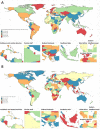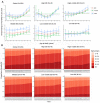Global, regional, and national burdens of atrial fibrillation/flutter from 1990 to 2019: An age-period-cohort analysis using the Global Burden of Disease 2019 study
- PMID: 37988383
- PMCID: PMC10662782
- DOI: 10.7189/jogh.13.04154
Global, regional, and national burdens of atrial fibrillation/flutter from 1990 to 2019: An age-period-cohort analysis using the Global Burden of Disease 2019 study
Abstract
Background: Atrial fibrillation/flutter (AF/AFL) significantly impacts countries with varying income levels. We aimed to present worldwide estimates of its burden from 1990 to 2019 using data from the Global Burden of Disease (GBD) study.
Methods: We derived cause-specific AF/AFL mortality and disability-adjusted life-year (DALY) estimates from the GBD 2019 study data. We used an age-period-cohort (APC) model to predict annual changes in mortality (net drifts), annual percentage changes from 50-55 to 90-95 years (local drifts), and period and cohort relative risks (period and cohort effects) between 1990 and 2019 by sex and sociodemographic index (SDI) quintiles. This allowed us to determine the impacts of age, period, and cohort on mortality and DALY trends and the inequities and treatment gaps in AF/AFL management.
Results: Based on GBD data, our estimates showed that 59.7 million cases of AF/AFL occurred worldwide in 2019, while the number of AF/AFL deaths rose from 117 000 to 315 000 (61.5% women). All-age mortality and DALYs increased considerably from 1990 to 2019, and there was an increase in age risk and a shift in death and DALYs toward the older (>80) population. Although the global net drift mortality of AF/AFL decreased overall (-0.16%; 95% confidence interval (CI) = -0.20, 0.12 per year), we observed an opposite trend in the low-middle SDI (0.53%; 95% CI = 0.44, 0.63) and low SDI regions (0.32%; 95% CI = 0.18, 0.45). Compared with net drift among men (-0.08%; 95% CI = -0.14, -0.02), women had a greater downward trend or smaller upward trend of AF/AFL (-0.21%; 95% CI = -0.26, -0.16) in mortality in middle- and low-middle-SDI countries (P < 0.001). Uzbekistan had the largest net drift of mortality (4.21%; 95% CI = 3.51, 4.9) and DALYs (2.16%; 95% CI = 2.05, 2.27) among all countries. High body mass index, high blood pressure, smoking, and alcohol consumption were more prevalent in developed countries; nevertheless, lead exposure was more prominent in developing countries and regions.
Conclusions: The burden of AF/AFL in 2019 and its temporal evolution from 1990 to 2019 differed significantly across SDI quintiles, sexes, geographic locations, and countries, necessitating the prioritisation of health policies based on risk-differentiated, cost-effective AF/AFL management.
Copyright © 2023 by the Journal of Global Health. All rights reserved.
Conflict of interest statement
Disclosure of interest: The authors completed the ICMJE Disclosure of Interest Form (available upon request from the corresponding author) and disclose no relevant interests.
Figures





References
-
- Dai H, Zhang Q, Much AA, Maor E, Segev A, Beinart R, et al. Global, regional, and national prevalence, incidence, mortality, and risk factors for atrial fibrillation, 1990-2017: results from the Global Burden of Disease Study 2017. Eur Heart J Qual Care Clin Outcomes. 2021;7:574-82. 10.1093/ehjqcco/qcaa061 - DOI - PMC - PubMed
MeSH terms
LinkOut - more resources
Full Text Sources
Medical
